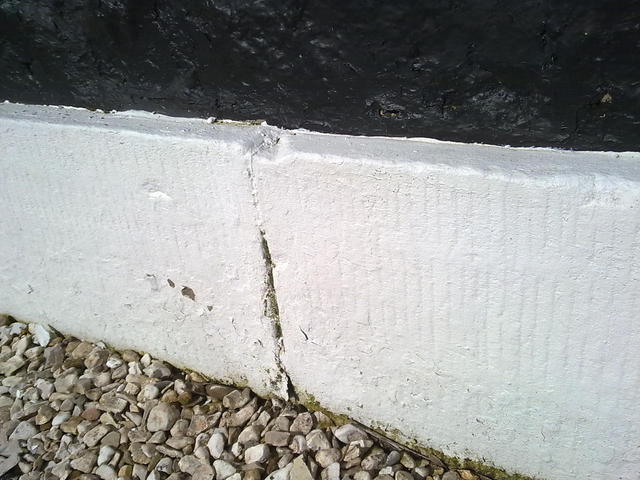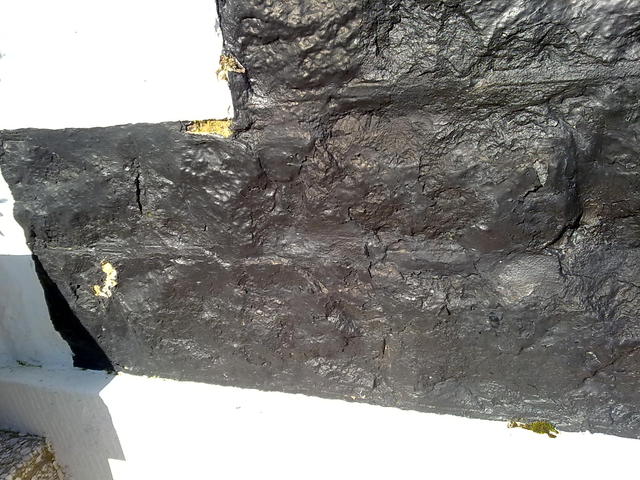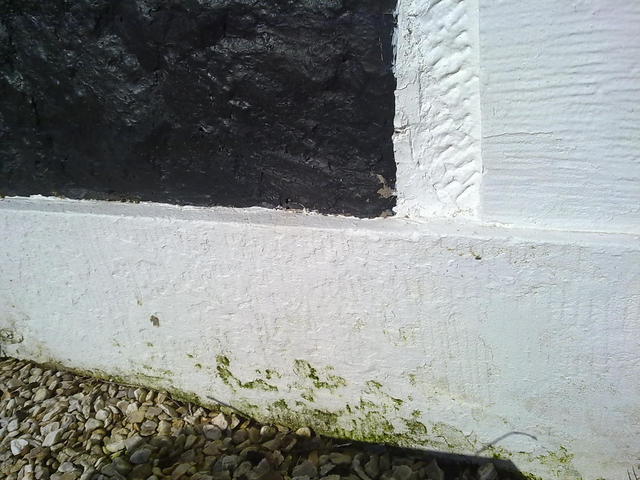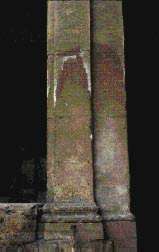We'd like to remind Forumites to please avoid political debate on the Forum... Read More »
📨 Have you signed up to the Forum's new Email Digest yet? Get a selection of trending threads sent straight to your inbox daily, weekly or monthly!
Painting house exterior, pics included - advice please :-)
budgie123_2
Posts: 58 Forumite
Ok, first, here are a few pics:



So, the house was built around 1880. We touched up the paintwork last year with a one coat exterior masonry textured paint. A year later, where we have painted has all flaked away and there is bits of moss and algae (I think it's algae?).
I was looking for advice on the best way to remove the flakes, moss and algae, and then advice on filling in the bits that we take out. The joins (cement?) between the stones where moss is growing feels damp and sandy and just seems to rub away quite easily. It is only small areas that are like this as in the photos, the rest seems ok.
And then also, do we need a certain kind of undercoat to prevent more moss etc, and what is the best type of paint to use? The one we used last year was a B&Q branded outdoor paint.
Sorry, I know it is a lot of questions. I'm just looking for a more permanent solution as touching it up every year is a pain and seems never ending.
Many thanks in advance :-)



So, the house was built around 1880. We touched up the paintwork last year with a one coat exterior masonry textured paint. A year later, where we have painted has all flaked away and there is bits of moss and algae (I think it's algae?).
I was looking for advice on the best way to remove the flakes, moss and algae, and then advice on filling in the bits that we take out. The joins (cement?) between the stones where moss is growing feels damp and sandy and just seems to rub away quite easily. It is only small areas that are like this as in the photos, the rest seems ok.
And then also, do we need a certain kind of undercoat to prevent more moss etc, and what is the best type of paint to use? The one we used last year was a B&Q branded outdoor paint.
Sorry, I know it is a lot of questions. I'm just looking for a more permanent solution as touching it up every year is a pain and seems never ending.
Many thanks in advance :-)
0
Comments
-
If your house was built in 1880, it's unlikely to have an effective damp proof course, and what you are seeing is the effect of moisture in the brick (or is it stone?) being drawn up by capillary action from the ground, getting behind the paint and blowing it off. This moisture will also be responsible for the moss / algae growth.
Short of something like an injected damp proof course (expensive), there's not a lot you can do as a permanent solution except try to avoid soil up against the wall (which you appear to have done anyway, unless the gravel on the pictures is only shallow).
If it's not all over, are there any different conditions applying to the better areas which you can transfer to the bad ones? e.g not putting anything against the wall which would hinder it drying out?
It wouldn't surprise me if your bad areas don't get much sun.A bank is a place that will lend you money if you can prove you don't need it.0 -
Unfortunately I think you may have caused your own problems. By the sounds of it, the mortar you mention is probably lime mortar, This never truly dries out and remains sandy and loose to a degree. The house when built was designed to 'breathe', unlike modern houses. That is, for a certain amount of moisture or damp to be present and penetrate, but for the circulation of air to be allowed to ventilate and dry it. By painting the house in a modern (presumably non-breathable) paint, you have trapped the existing moisture in the fabric of the house, and also meant that any moisture travelling up the wall in the manner that bob mentioned, to remain trapped also. This will not only cause the paint to flake off, but also ultimately cause damp to penetrate into the house.
Sorry to be the bearer of bad news.
As for solutions?
You could try an injected DPC, and then patch the failing spots and hope their is not too much existing damp in the walls, but then you have to consider do the floors have a DPM because if not, damp will just penetrate through the floors and will be trapped in the house.
You could sand blast off all the paint from the house, re-point in lime mortar (because the mortar will have been blasted out as well due to it being weak) and either leave it unpainted or re paint in a breathable exterior paint.
I think you need to get either a builder or surveyor with experience of period property to have a better look and advise you.
Olias0 -
I have a simialrly ages house and was actually told by a fully qualified surveyor to no paint the bottom layer near the ground as it prevents the wall breathing. My situation is slightly different as my exterior walls are rendored so the bottom couple of brick layers need to be exposed to prevent the wall becoming damp and unable to dry out.
When asked about other solutions like DPC etc he said, no, just remove the paint and it will be fine.
Hope it helps.
NivYNWA
Target: Mortgage free by 58.0 -
It doesn't matter a brass farthing whether this house has a DPC or not because the paint in question is clearly below the level at which a DPC would be installed if it had one. Keep painting OP.
CheersThe difference between genius and stupidity is that genius has it's limits. - Einstein0 -
Wow, thanks very much for the replies! :-)
I am confused though. Thinking, right, I have to get all the paint off and repoint the whole house....that will cost an arm and a leg....probably more :-)
So, I was reading about an exterior paint stripping product: http://www.stripperspaintremovers.com/I_want_to_remove.htm#11 which is applied and left for a while and then power washed off. (I read that sandblasting would be a very bad option and very damaging?)
And then this breathable, natural paint: http://www.earthbornpaints.co.uk/natural-exterior-wall-paint.php
The upper parts of the house are fine with maybe a little bit flaking off here or there, but no moss or anything like that.
So, my question is, could I strip off all the affected paint right along the whole front of the house up to the ledge where the colour changes to black, (so the bottom 10 or 12 inches), point any gaps with lime mortar....and then use the breathable paint? Does that sound sensible?
Thanks again, really appreciate the replies.0 -
Wait until the height of summer..and dig out below that gravel line...then ..after a week of warm weather ...paint all stonework below soil level with tanking ..or 3 or 4 coats of bitumastic ..at least 1/8 thick
now then ..bitumastic...drys out itself ..and will become dry and brittle and flaky ..in probably five years .
so let the bitumastic dry for about two weeks ..then overcoat it with gloss paint...this will seal the bitumastic and keep it flexible for years.
once done ..pile your chippings back against where they where
Bitumastic is cheap ..its about £8 for 2.5 litres
all the best.markj0 -
It's difficult to tell from the pics, but is the main body of the house stone or brick? Was it already painted? If so, what condition was that paintwork in?
Although your plan is a good start budgie (and obviously cheaper), the problem is that if the house is a porous stone like say sandstone, then rising damp can easily rise to 1.5 metres which will go beyond the foundation stones and behind the black paint and again, potentially ingress into the house as it can't evaporate through the stonework as the building was designed for it to do because of the paint. I couldn't find a very good pic, but this one below should give you an idea of what I mean - the 'tide mark' shows how far damp has travelled up this stone previously. If it had been painted with a modern non breathable paint, the damp would not have been able to evaporate, but would have renmained trapped behind the paint and in your case could migrate through to the internal plaster/paper/woodwork etc.
I think your options are to try your plan and see if that works, or else get hold of a surveyor experienced in period properties and ask their advice.
Whatever you do, don't get a damp specialist firm in, as they will have a vested interest in flogging you whatever product or service they provide and will be unlikely to give you impartial advice.
edit - sorry crossed posts, just noticed post #8 I think this is really bad advice by aboard-epsilon. It will stop damp ingress laterally through hydrostatic pressure, but will not stop the damp rising through capilliary action, and will just serve to trap such damp even more! The option I refer to in my post is that of the OP, not aboard-epsilon.
Olias0 -
edit - sorry, just noticed post #8 I think this is really bad advice by aboard-epsilon. It will stop damp ingress laterally through hydrostatic pressure, but will not stop the damp rising through capilliary action, and will just serve to trap such damp even more!
Olias
it was just an idea ..if you paint the wall right down to the bottom of the foundations it may work ..possbly the stone work is laid on slate ..i don't know...
i was on about all stone work below ground ..above ground can be painted with porous masonry paint..
anyway ...what about people doing tanking on the inside of a house..thats just holding back the damp but the stone work will still be saturated behind it..
another idea is that you could dig out even more and put in more chippings ..whole lot leading off to a big soak away...that only works if the base of the house is above somewhere lower.
all the best.markj0 -
Yes.So, my question is, could I strip off all the affected paint right along the whole front of the house up to the ledge where the colour changes to black, (so the bottom 10 or 12 inches)
Not unles you've aleady scraped all the pointing out - leave it be but don't forget its friable.point any gaps with lime mortar....
No - leave it au naturel.and then use the breathable paint?
CheersThe difference between genius and stupidity is that genius has it's limits. - Einstein0 -
aboard_epsilon wrote: »anyway ...what about people doing tanking on the inside of a house..thats just holding back the damp but the stone work will still be saturated behind it..
another idea is that you could dig out even more and put in more chippings ..whole lot leading off to a big soak away...that only works if the base of the house is above somewhere lower.
The stonework being damp is not really a problem, it's that damp travelling through to the inside and causing damage to wood/plaster/decoration. Hence tanking is a suitable method of damp proofing as it keeps the damp out of the interior of the building.
Soakaway sounds an idea though, it would help a lot, but would have to be done properly with a proper french drain etc.
Olias0
This discussion has been closed.
Confirm your email address to Create Threads and Reply

Categories
- All Categories
- 351.6K Banking & Borrowing
- 253.3K Reduce Debt & Boost Income
- 453.9K Spending & Discounts
- 244.6K Work, Benefits & Business
- 599.9K Mortgages, Homes & Bills
- 177.2K Life & Family
- 258.2K Travel & Transport
- 1.5M Hobbies & Leisure
- 16.2K Discuss & Feedback
- 37.6K Read-Only Boards

